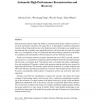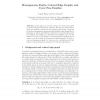111 search results - page 17 / 23 » Minimum-cost network hardening using attack graphs |
CN
2007
13 years 7 months ago
2007
Self-protecting systems require the ability to instantaneously detect malicious activity at run-time and prevent execution. We argue that it is impossible to perfectly self-protec...
CCS
2007
ACM
14 years 2 months ago
2007
ACM
The paper describes a Non-Intrusive IP traceback scheme which uses sampled traffic under non-attack conditions to build and maintains caches of the valid source addresses transiti...
ACSAC
2005
IEEE
14 years 1 months ago
2005
IEEE
In this paper, we present techniques for a network forensics analysis mechanism that includes effective evidence presentation, manipulation and automated reasoning. We propose the...
ICITS
2011
12 years 11 months ago
2011
In this paper, we use the concept of colored edge graphs to model homogeneous faults in networks. We then use this model to study the minimum connectivity (and design) requirements...
CISC
2009
Springer
13 years 5 months ago
2009
Springer
The anticipation game framework is an extension of attack graphs based on game theory. It is used to anticipate and analyze intruder and administrator concurrent interactions with ...


